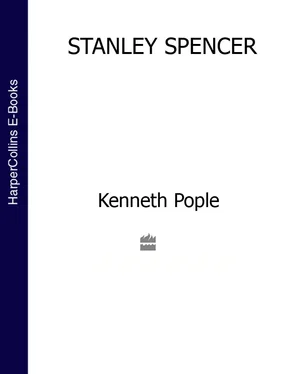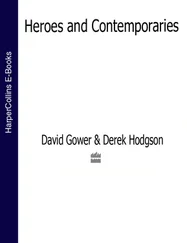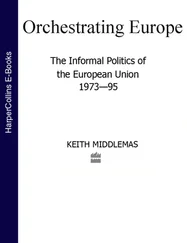In venturing today into this study of Spencer’s life and art, boldness is offered; but it is boldness disciplined by the sense of the totality of his experience. An artistic interpretation which ignores Spencer’s material existence will remain truncated. Yet a biography which blinds itself to the revelation in his paintings of the facts of his existence can only perpetuate the superficiality which saw him – and sometimes sees him still – as whimsical or innocent or unworldy or even as blasphemer or pornographer. His oddities are, like the highly personal and visionary paintings he undertook, sudden flashes of lightning, often charged over long periods, which momentarily illuminate climaxes in a continuous procession in his mind, an inner pageant. The pageant overwhelmed him. To its service he dedicated both his art and his everyday existence. When he could reconcile them, he knew happiness. When they conflicted, he was torn. The demands of art invariably won, but the cost in material sacrifice could be cruelly high.
It would be a rash interpreter who claimed complete elucidation for so complex a personality. Spencer used his art to explain himself to himself. As with the poetry and prose of his contemporaries Eliot, Pound and Joyce, it is the exactness of personal detail in Spencer’s paintings which makes so many incomprehensible or uncomfortable. But the paintings were not intended to prompt discomfort. He lived in hope that the public would catch up with him. His art, perceived through sympathetic understanding of his life, can reveal a transcendent outlook, an intriguing and majestic vision of life which some may dismiss as no more than typical of his time, but which most may joyously recognise as having eternal and universal import.
A work of great art – pictorial, musical or literary – reaches out and touches some profundity in our nature independently of its maker. Awed, we may wish to know more of him or her. The quest is often disappointing. We can know nothing of Homer, little of Dante or Shakespeare. Of later artists, of whom we can search to know more, we sometimes ask ourselves how such fallible men and women could produce such sublimity. The purpose of this study is not to dissect Spencer and his art. Rather is it to recapture through the medium of his own words that sense of the wondrous and mysterious through which he became someone other than the everyday artist people thought they knew, and entered a heaven of his own which he felt he had to strive, through imagery, to share with us. Thus the narrative pauses at some of the major paintings representative of the main periods and events of Spencer’s life and offers suggestions as to their emotional origins. (The majority have been chosen as being available in public galleries. They may not always be on display, but can usually be seen by prior arrangement.)
Throughout this book, Spencer – Sir Stanley Spencer CBE, RA, Hon. D. Litt. – is referred to as ‘Stanley’, not as a mark of familiarity, but in order to distinguish him from his many brothers, and especially from his artist-brother Gilbert, with whom he was sometimes confused. Textually his writings have been rendered into conventional spelling and punctuation, no easy matter at times when he was in full flight. Occasionally bracketed insertions have been made to catch the sense of his often elided thought.
The obvious starting-point for the search for Stanley’s inner pageant must be the Thames-side village of Cookham where, in the cool unsettled summer of 1891, on 30 June, he was born.
PART ONE
The Early Cookham Years
1891–1915
CHAPTER ONE
The Coming of the Wise Men
I am actually old enough to remember the Victorian Age; and it was almost a complete contrast to all that is now connoted by that word. It had all the vices that are now called virtues; religious doubt, intellectual unrest, a hungry credulity about new things, a complete lack of equilibrium. It also had all the virtues that are now called vices; a rich sense of romance, a passionate desire to make the love of man and woman once more what it was in Eden, a strong sense of the absolute necessity of some significance in human life.
G. K. Chesterton: Autobiography 1
COOKHAM VILLAGE lies some thirty miles from London along the favoured stretch of the Thames from Henley, past Marlow and Cliveden, to Boulter’s Lock and Maidenhead Bridge. It rests on the slightest of rises at a point where the eastward-flowing river makes an abrupt right-angle bend south against the bluffs of Cliveden Woods. Lying within the elbow of the bend, the village is in effect an island, for the river may once have made its course on the other side of the rise, isolating it today by its low-lying remnants – Marsh Meadows to the north, Cookham Moor to the west, Widbrook Common to the south, and Odney Common to the east. These water-meadows often flooded in Stanley’s boyhood, and the winter rising of the river was anxiously watched, as Stanley’s brother Sydney notes in his diary for January 1912: ‘I went up the river and saw the heron high in the air flying towards Hedsor, dim in the rain. A peewit and a seagull met, exchanged compliments by numerous tumblings, then went their several ways. Cattle were taken off the Moor this morning and pigs from Randall’s styes this evening.’ 2For this reason extension of the village has not been possible and under protective preservation it remains virtually as Stanley knew it in his boyhood.
A few cosmetic alterations have occurred. The malthouses whose cowls once dominated the village have gone, the blacksmith’s forge is now a restaurant, the village shops have become boutiques or tea rooms, Ovey’s Farm in the High Street is now a residence, its barns a garage and filling station, and the former Methodist Chapel is now the Stanley Spencer Gallery. But in its structural appearance the village remains much as it was in the early decades of the nineteenth century when Stanley’s paternal grandfather arrived from Hertfordshire to help build the superior residences locked inside their high red-brick walls which Victorian genteel wealth and the new commuter railway system from London were imposing on the neighbourhood. A builder by profession but a musician by inclination – he inaugurated a village choir – Grandpa Julius prospered sufficiently to produce two families by two marriages, thus giving Stanley a profusion of ‘cousins’ in the village. His Spencers were the product of Grandpa Julius’ second marriage.
For the two sons of the marriage, Grandpa Julius demolished a row of small cottages in the High Street and replaced them with a pair of semi-detached villas. The elder son, Julius, occupied Belmont, the left-hand villa facing from the road. He had a family of daughters – Stanley’s ‘girl-cousins’ – and was managing clerk to a firm of London solicitors. The younger son, William – ‘Pa’ to Stanley – occupied the right-hand villa, Fernlea, and was a dedicated musician. The piano and violin being Victorian social accomplishments much in demand, he set up as the local music ‘professor’, cycling to teach the children of the grand middle-class houses – Rosamond Lehmann remembers a ‘gentle old man with a white beard’ – and welcoming the humbler in his home. 3The succession of little girls sitting in the hall awaiting their piano lesson was a long-standing Stanley memory, and he did much of his early painting to the accompaniment of their halting efforts.
Pa supplemented his income by acting as church organist, mainly at St Nicholas, Hedsor, in the advowson of Lord and Lady Boston. Lord Boston had been one of his piano pupils, and in those days of discreet patronage the Bostons did much to help their church organist. They allowed him, for example, to enjoy the study of the stars in their private observatory and on one occasion met his expenses on a cycling holiday along the south coast while his wife, Annie, relaxed at Eastbourne. From his Pa, Stanley asserted, he took his ‘sense of wonder’, and from Ma his small frame and his sense of the dramatic. Ma was an excellent mimic, a gift which Stanley inherited and could use to social effect. 4
Читать дальше









![Brian Thompson - A Monkey Among Crocodiles - The Life, Loves and Lawsuits of Mrs Georgina Weldon – a disastrous Victorian [Text only]](/books/704922/brian-thompson-a-monkey-among-crocodiles-the-life-thumb.webp)


